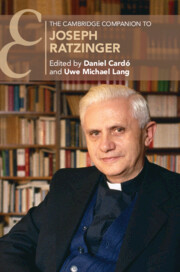100 results

The Cambridge Companion to Joseph Ratzinger
-
- Published online:
- 25 January 2024
- Print publication:
- 21 December 2023
Acknowledgments
-
- Book:
- The Cambridge Companion to Joseph Ratzinger
- Published online:
- 25 January 2024
- Print publication:
- 21 December 2023, pp x-x
-
- Chapter
- Export citation
Part III - Dialogue and Perspectives
-
- Book:
- The Cambridge Companion to Joseph Ratzinger
- Published online:
- 25 January 2024
- Print publication:
- 21 December 2023, pp 313-367
-
- Chapter
- Export citation
2 The Longitudinal Relationship Between Concussion History, Years of Football Participation, and Alcohol Use Among Former National Football League (NFL) Players: an NFL-LONG Study
-
- Journal:
- Journal of the International Neuropsychological Society / Volume 29 / Issue s1 / November 2023
- Published online by Cambridge University Press:
- 21 December 2023, pp. 114-115
-
- Article
-
- You have access
- Export citation
13 - Liturgy
- from Part II - Main Themes
-
-
- Book:
- The Cambridge Companion to Joseph Ratzinger
- Published online:
- 25 January 2024
- Print publication:
- 21 December 2023, pp 211-226
-
- Chapter
- Export citation
Contents
-
- Book:
- The Cambridge Companion to Joseph Ratzinger
- Published online:
- 25 January 2024
- Print publication:
- 21 December 2023, pp v-vi
-
- Chapter
- Export citation
Part I - Life and Context
-
- Book:
- The Cambridge Companion to Joseph Ratzinger
- Published online:
- 25 January 2024
- Print publication:
- 21 December 2023, pp 1-56
-
- Chapter
- Export citation
Part II - Main Themes
-
- Book:
- The Cambridge Companion to Joseph Ratzinger
- Published online:
- 25 January 2024
- Print publication:
- 21 December 2023, pp 57-312
-
- Chapter
- Export citation
Copyright page
-
- Book:
- The Cambridge Companion to Joseph Ratzinger
- Published online:
- 25 January 2024
- Print publication:
- 21 December 2023, pp iv-iv
-
- Chapter
- Export citation
Index
-
- Book:
- The Cambridge Companion to Joseph Ratzinger
- Published online:
- 25 January 2024
- Print publication:
- 21 December 2023, pp 368-373
-
- Chapter
- Export citation
Editors’ Preface
-
- Book:
- The Cambridge Companion to Joseph Ratzinger
- Published online:
- 25 January 2024
- Print publication:
- 21 December 2023, pp vii-ix
-
- Chapter
- Export citation
Contributors
-
- Book:
- The Cambridge Companion to Joseph Ratzinger
- Published online:
- 25 January 2024
- Print publication:
- 21 December 2023, pp xi-xii
-
- Chapter
- Export citation
Mental health symptoms and their associated factors among pharmacists in psychiatric hospitals during the early stage of the COVID-19 pandemic
-
- Journal:
- Cambridge Prisms: Global Mental Health / Volume 10 / 2023
- Published online by Cambridge University Press:
- 06 November 2023, e77
-
- Article
-
- You have access
- Open access
- HTML
- Export citation
Supporting return to work after psychiatric hospitalization—A cluster randomized study (RETURN-study)
-
- Journal:
- European Psychiatry / Volume 66 / Issue 1 / 2023
- Published online by Cambridge University Press:
- 09 January 2023, e9
-
- Article
-
- You have access
- Open access
- HTML
- Export citation
5 - Roman Stational Liturgy
-
- Book:
- The Roman Mass
- Published online:
- 08 September 2022
- Print publication:
- 29 September 2022, pp 154-213
-
- Chapter
- Export citation
Copyright page
-
- Book:
- The Roman Mass
- Published online:
- 08 September 2022
- Print publication:
- 29 September 2022, pp iv-iv
-
- Chapter
- Export citation
Introduction
-
- Book:
- The Roman Mass
- Published online:
- 08 September 2022
- Print publication:
- 29 September 2022, pp 1-6
-
- Chapter
- Export citation
Epilogue
-
- Book:
- The Roman Mass
- Published online:
- 08 September 2022
- Print publication:
- 29 September 2022, pp 391-392
-
- Chapter
- Export citation
3 - Development of Eucharistic Prayers in the Third and Fourth Century
-
- Book:
- The Roman Mass
- Published online:
- 08 September 2022
- Print publication:
- 29 September 2022, pp 78-103
-
- Chapter
- Export citation
Abbreviations
-
- Book:
- The Roman Mass
- Published online:
- 08 September 2022
- Print publication:
- 29 September 2022, pp xi-xii
-
- Chapter
- Export citation

